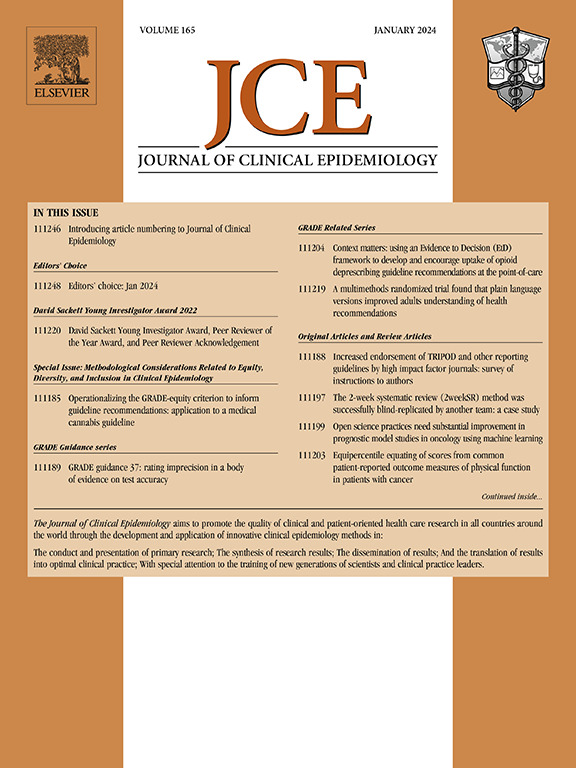Endpoint assessment via routinely collected data generates estimates comparable to randomized controlled trial data: analysis of a cluster-randomized trial on fall injury prevention
IF 7.3
2区 医学
Q1 HEALTH CARE SCIENCES & SERVICES
引用次数: 0
Abstract
Background and Objectives
Routinely collected data (RCD) from healthcare claims and encounters are increasingly used for outcomes in randomized trials; however, methods for estimating the validity and relative precision of RCD-derived outcomes compared to those from conventional outcome ascertainment are limited. We developed an approach to measuring validity and relative precision of RCD and quantifying uncertainty.
Methods
We reanalyzed data from the Strategies to Reduce Injuries and Develop Confidence in Elders (STRIDE) cluster-randomized, controlled trial. Eighty-six primary care practices in 10 US healthcare systems were randomized to either a multifactorial intervention delivered by nurse falls care managers, or enhanced usual care, with 5451 persons age ≥ 70 at increased fall injury risk enrolled in the study. We estimated the hazard ratio (HR) and confidence interval (CI) for STRIDE's primary outcome (time to first serious fall injury) using original study data and RCD. The ratio of the RCD HR to original HR (“ratio of HRs”) measured validity. The confidence limit ratio (CLR; upper divided by lower confidence limits of CI) measured precision, with the ratio of the CLR with RCD to the CLR from the original study data (“ratio of CLRs”), measuring relative precision. We estimated uncertainty around the ratio of HRs and ratio of CLRs using bootstrapped 95% CIs and performed sensitivity analyses to assess the effects of adaptations needed to use RCD.
Results
Among the original sample of 5451 study participants, 5036 (92%) were linked to RCD. The intervention to control HR was 0.91 (95% CI: 0.78–1.07) in RCD, compared to 0.92 (95% CI: 0.80–1.06) in the original data. Using all RCD through STRIDE's administrative end date, the ratio of HRs was 1.00 (95% CI: 0.89–1.11) and ratio of CLRs was 1.03 (95% CI: 0.96–1.06). The CI around ratio of HRs was about three-fold wider for RCD than for the original STRIDE data in individuals who linked to RCD. Relative precision of RCD improved with increased length of follow-up.
Conclusion
Relying solely on RCD to ascertain the primary outcome in STRIDE would have resulted in similar point estimates and confidence limits for the treatment effect as in the original data. However, there was meaningful uncertainty around the estimate of validity. Efforts to validate RCD-derived outcomes for use as clinical trial endpoints should include measurement of uncertainty around validity estimates.
终点评估通过常规收集的数据产生的估计与随机对照试验数据相当:对跌倒损伤预防的集群随机试验的分析。
背景和目的:从医疗索赔和就诊中常规收集的数据(RCD)越来越多地用于随机试验的结果;然而,与传统结果确定方法相比,估计rcd衍生结果的有效性和相对精度的方法是有限的。我们开发了一种测量RCD效度和相对精度以及量化不确定度的方法。方法:我们重新分析了来自“老年人减少伤害和培养信心策略”(STRIDE)集群随机对照试验的数据。来自美国10个医疗保健系统的86个初级保健实践被随机分配到由护士跌倒护理管理人员提供的多因素干预或增强的常规护理中,5451名年龄≥70岁、跌倒损伤风险增加的人参加了这项研究。我们使用原始研究数据和RCD估计STRIDE主要结局(到首次严重跌倒损伤的时间)的风险比(HR)和置信区间(CI)。RCD人力资源与原始人力资源之比(“人力资源之比”)衡量效度。置信限比(CLR;上除以CI的下置信限)测量精度,用RCD的CLR与原始研究数据的CLR之比(“CLR之比”)测量相对精度。我们使用自举95% ci估计hr和clr比值的不确定性,并进行敏感性分析以评估使用RCD所需的适应效果。结果:在5451名研究参与者的原始样本中,5036名(92%)与RCD相关。在RCD中,干预对控制的HR为0.91 (95% CI: 0.78-1.07),而在原始数据中为0.92 (95% CI: 0.80-1.06)。使用截至STRIDE治疗结束日期的所有RCD, hr的比值为1.00 (95% CI: 0.89-1.11), clr的比值为1.03 (95% CI: 0.96-1.06)。在与RCD相关的个体中,RCD的hr周围CI比原始STRIDE数据宽约3倍。RCD的相对精确度随着随访时间的延长而提高。结论:仅依靠RCD来确定STRIDE的主要结局将产生与原始数据相似的治疗效果的点估计和置信限。然而,在效度估计周围存在有意义的不确定性。验证rcd衍生结果作为临床试验终点的努力应包括测量有效性估计的不确定性。
本文章由计算机程序翻译,如有差异,请以英文原文为准。
求助全文
约1分钟内获得全文
求助全文
来源期刊

Journal of Clinical Epidemiology
医学-公共卫生、环境卫生与职业卫生
CiteScore
12.00
自引率
6.90%
发文量
320
审稿时长
44 days
期刊介绍:
The Journal of Clinical Epidemiology strives to enhance the quality of clinical and patient-oriented healthcare research by advancing and applying innovative methods in conducting, presenting, synthesizing, disseminating, and translating research results into optimal clinical practice. Special emphasis is placed on training new generations of scientists and clinical practice leaders.
 求助内容:
求助内容: 应助结果提醒方式:
应助结果提醒方式:


